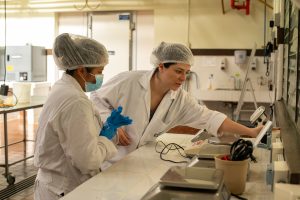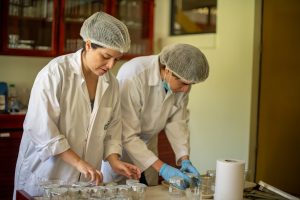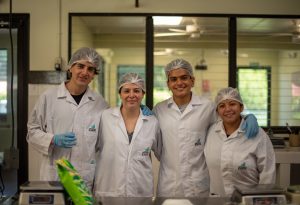The Science of Making Food
 When Aracelly Cordero was a child, she once watched as a container of cow’s milk turned what seemed like magically into frozen yogurt. She watched her father work, carefully observing a process that intrigued her and made her wonder, “How does food become the products we consume? How does milk turn into yogurt ice cream?” Aracelly was still young when she decided she wanted to pursue this magical process she saw happening in front of her, even though she didn’t know exactly what it was.
When Aracelly Cordero was a child, she once watched as a container of cow’s milk turned what seemed like magically into frozen yogurt. She watched her father work, carefully observing a process that intrigued her and made her wonder, “How does food become the products we consume? How does milk turn into yogurt ice cream?” Aracelly was still young when she decided she wanted to pursue this magical process she saw happening in front of her, even though she didn’t know exactly what it was.
 Today, Aracelly is a professor of Food Processing at our University. Her childhood curiosity led her to study Food Engineering at the University of Costa Rica and, later, to pursue a Masters Degree Design Thinking and Product Development at the University of Barcelona.
Today, Aracelly is a professor of Food Processing at our University. Her childhood curiosity led her to study Food Engineering at the University of Costa Rica and, later, to pursue a Masters Degree Design Thinking and Product Development at the University of Barcelona.
 “When I was a student, I realized I wasn’t studying physics, chemistry, or biology, but instead was using the fundamentals of all the sciences to create something that we all need several times a day: food.”
“When I was a student, I realized I wasn’t studying physics, chemistry, or biology, but instead was using the fundamentals of all the sciences to create something that we all need several times a day: food.”
Over time she connected her studies with agriculture and began to think about how to make products that would improve food systems and be healthier, more sustainable, and more accessible to all people. While she was working for different companies, Aracelly connected with farmers. She became interested in their production processes and in understanding where the raw materials and foods that make up other products come from.
 Since Aracelly joined the faculty at EARTH, her mission has been to train students to find food solutions within their geographic, social, and climatological contexts. For example, she challenges them in some lessons to create a product that can meet needs in times of crisis, such as drought, pandemics, or earthquakes. Her students experiment with different processes and raw materials to find a transformative tool in food science to combat hunger and malnutrition.
Since Aracelly joined the faculty at EARTH, her mission has been to train students to find food solutions within their geographic, social, and climatological contexts. For example, she challenges them in some lessons to create a product that can meet needs in times of crisis, such as drought, pandemics, or earthquakes. Her students experiment with different processes and raw materials to find a transformative tool in food science to combat hunger and malnutrition.
 Aracelly ensures that in her classes, students learn by practicing the theoretical concepts she teaches before moving on to the laboratory. They can observe how each procedure works and analyze and draw conclusions from their results to make possible improvements. The students must understand the science and the reasoning behind the steps to follow when making, for example, a cheese, a jam, or a fermented product, and if they make a mistake, they must be able to identify what it was and how to solve it.
Aracelly ensures that in her classes, students learn by practicing the theoretical concepts she teaches before moving on to the laboratory. They can observe how each procedure works and analyze and draw conclusions from their results to make possible improvements. The students must understand the science and the reasoning behind the steps to follow when making, for example, a cheese, a jam, or a fermented product, and if they make a mistake, they must be able to identify what it was and how to solve it.
 “I also learn a lot as a professor. Sometimes, while explaining a process, someone raises their hand and tells me that it is done differently in their country. I give them the marker and invite them to go to the whiteboard so that we all learn, and other students see that in their countries, it is done the same way or similarly. This leads to a vibrant exchange, which I take advantage of so that they and I grow even more.”
“I also learn a lot as a professor. Sometimes, while explaining a process, someone raises their hand and tells me that it is done differently in their country. I give them the marker and invite them to go to the whiteboard so that we all learn, and other students see that in their countries, it is done the same way or similarly. This leads to a vibrant exchange, which I take advantage of so that they and I grow even more.”
We are proud to benefit from the expertise of Professor Aracelly Cordero, a woman who uses science to improve food systems and who is passionate about dynamically transferring this passion and knowledge to her students.




